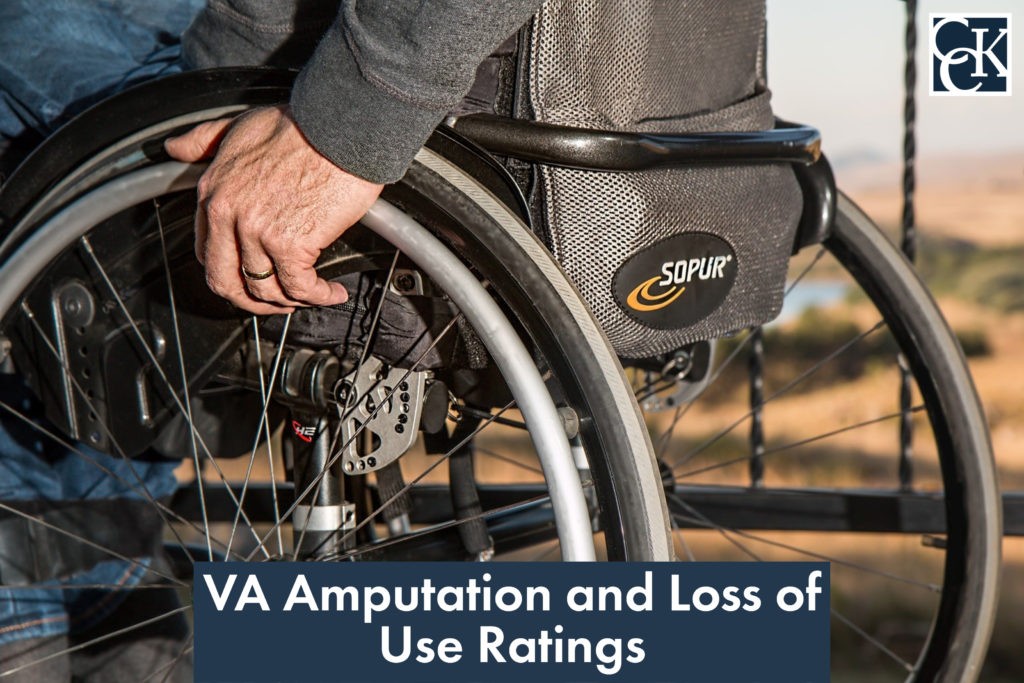VA Amputation and Loss of Use Ratings

CCK Law: Our Vital Role in Veterans Law
If you suffer from an amputation or loss of use of a part of your body as a result of your military service, you may be entitled to additional VA disability benefits in the form of Special Monthly Compensation (SMC). Specifically, SMC is a monthly benefit for veterans who have service-connected conditions that result in severe impairment, including the loss of use of extremities, blindness, the need for regular aid and attendance, and more.
Veterans do not have to apply for this benefit in order to raise the issue before VA. Rather, when reviewing a veteran’s claim for benefits, VA should consider if the veteran is entitled to SMC and grant the benefit if it is warranted. Importantly, SMC rates, except that of SMC (K), which applies in most cases of loss of use, are paid instead of a veteran’s VA disability rating, not in addition to their disability compensation.
In this article, CCK Law will discuss
- Amputation and VA disability ratings
- Loss of use
- And more

Amputation and VA Disability Ratings
Upper Extremities
VA categorizes amputation in terms of traumatic amputation or amputation by surgical removal. There are different VA disability ratings based on the different types of amputations. For example, VA rates amputations of the arms and hands under 38 CFR § 4.17a (Diagnostic Codes 5120 – 5125) as follows:
- 100% – amputation of entire arm, including the shoulder, scapula, clavicle, and/or ribs, either arm
- 90% – amputation of the entire arm from the shoulder down, either arm
- 90% – amputation below the shoulder but above the elbow for the dominant arm (80% for the non-dominant arm)
- 80% – amputation for below the deltoid but above the elbow for the dominant arm (70% for the non-dominant arm)
- 80% – amputation above the pronator teres for the dominant arm (70% for the non-dominant arm)
- 70% – amputation below the insertion of pronator teres for the dominant arm (60% for the non-dominant arm
- 70% – amputation of the dominant hand (60% for the non-dominant hand
Importantly, for amputation of both arms or hands, VA should award a 100% disability rating.
Lower Extremities
In terms of amputations of the legs and feet, VA uses the same regulation (i.e., 38 CFR § 4.17a, Schedule of Ratings – Musculoskeletal System) to issue the following ratings:
- 100% – amputation of the leg, including any part of the pelvic bone
- 90% – for amputation of the leg at the hip
- 80% – for amputation of the leg at the upper thigh
- 60% – for amputation of the leg at the mid- to lower thigh
- 60% – for cases where a second amputation has been required due to complications from the first amputation
- 60% – for amputations that render the knee joint unstable
- 40% – for amputation of the leg below the knee
- 40% – for amputation that renders the foot or ankle unusable
- 10 – 40% – various rankings for different levels of foot amputations
Again, if amputation of both legs or feet is present, VA should award a 100% disability rating. It is also important to note that VA does not make a distinction between the dominant and non-dominant extremities when rating amputations of the legs and feet.
Temporary Total Ratings Due to Convalescence
If a veteran’s amputation requires extensive periods of hospitalization or convalescence, it can be rated at 100% disabling for a certain period of time. This time period usually lasts for 3 months, at which time VA will re-evaluate based on the rating criteria listed above.
Loss of Use
According to VA, loss of use is held to exist when a part of the body would function equally as well as an amputation with the use of a suitable prosthesis. Importantly, amputation is not required to experience loss of use. Determinations of loss of use are made on the basis of the actual remaining function of the upper or lower extremities (e.g., hand or foot). In regard to determining loss of use of one or both hands, VA considers a veteran’s ability to carry out acts of grasping, manipulation, etc.
In terms of loss of use of one or both feet, VA considers acts of balance, propulsion, etc. Loss of use does not need to be the result of any one particular injury or illness. While loss of use of the hands and feet is very common for VA rating purposes and SMC benefits, loss of use can also be applied to the following:
- An immobilized joint or paralyzed limb
- Loss of use of a reproductive organ
- Loss of sight in one eye
- Deafness in both ears
- Inability to communicate by speech
- Loss of a breast, or both breasts, from mastectomy or radiation treatment
Was Your Loss of Use or Amputation VA Claim Denied?
The experienced attorneys at Chisholm Chisholm & Kilpatrick have decades of experience successfully representing Veterans and their dependents before the Department of Veterans Affairs and the Court of Appeals for Veterans Claims. We may be able to help. Contact us online or call us at (800) 544-9144 for a free case evaluation with a member of our team.
About the Author
Share this Post
